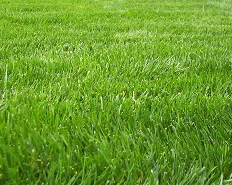Keeping with our fall transition theme, have you thought about what type of rye grass you’re going to plant-annual or perennial? There are a few things you should consider before you head to your local nursery and purchase your seed.
Annual Rye
Annual rye is bunch grass that produces a light green color and a wider leaf blade compared to perennial rye grass. It germinates quickly-between 7-10 days, and its optimal mowing height is between 2″-3″. This grass does not do well when consistently mowed at lower heights like a perennial rye grass.
Annual rye has a one-year growth cycle and will die when the temperatures increase in the spring. Its heat tolerance is low compared to perennial; it will die off earlier than perennial rye. When it’s not well maintained and allowed to produce seed heads, the seed will germinate when temperatures decrease again and will act as a weed. Also, the wear tolerance is low, so it would be the wrong selection to use for such applications as ball fields, yards with children and pets, golf courses, etc.
Positives and Negatives of Annual Rye
Pros: low cost, less maintenance, easy spring transition
Cons: poor turf quality, low traffic tolerance, and will not tolerate sustained low mowing.

Perennial Rye
Perennial rye is a bunch grass that produces a deep green color with narrow leave blades. It produces more shoots per square inch than annual rye grass, giving it a more plush, carpet like look. It can be mowed as low as 1/4″ but usually is maintained at heights between 3/4″ to 1 1/2″. Sometimes perennial rye comes in blends, multiple varieties within the species, to achieve different results. One variety may germinate quickly, while the other variety can handle heavy traffic conditions. The idea is to promote optimal growth and appearance throughout the growing season. It’s not uncommon to see 3-4 different varieties in a blend.
Ask your local nursery about the benefits of each variety.
Perennial rye is more heat tolerant than annual rye, but the severe desert heat will eventually kill the perennial, so it’s not a true perennial in our region of the country and will need to be reseeded the following year. However, if you do live in higher elevations where the temperatures are more temperate, it’s not uncommon to see this species survive late into the summer months.
Positives and Negatives of Perennial Rye
Pros: high turf quality, high traffic tolerance, quick germination, tolerates low mowing, produces a very deep green color
Cons: higher initial cost, heat-tolerant making spring transition difficult, higher maintenance requirement

There are distinct qualities of annual and perennial rye grass, and they must be considered before you make your final decision on which grass you will select. We at Southwest Sod know your lawn is a huge investment, so remember, if you have any questions, please contact us at 602-271-4266. We have eager staff waiting to help you solve any of your turf grass needs.

